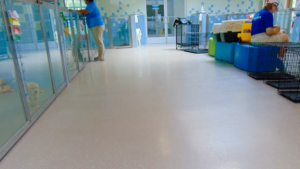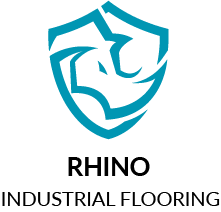Do you need flooring that is both comfortable and durable enough to withstand the wear and tear of animals? Are you looking for a solution that provides your veterinary practice with long-lasting safety and hygiene. If so, consider animal and veterinary flooring.
From rubber mats to anti-fatigue runners designed specifically for veterinary applications, this type of flooring offers numerous benefits to help everyone from pet owners to veterinarians. In this blog post, we will discuss why installing specialized animal care floors in your facility is beneficial as well as different types of options available.

Benefits of Animal & Veterinary Flooring
Animal and veterinary facilities require a flooring solution that is durable, safe, and easy to maintain. This is important not only for the comfort and well-being of the animals, but also for the safety of workers and visitors. By investing in high-quality animal and veterinary flooring, you can ensure that your facility meets all necessary standards and regulations, while also providing numerous benefits to your business and the animals in your care. Some of the main advantages of animal and veterinary flooring include:
Durability
Animal and veterinary facilities are subject to heavy wear and tear, including scratches from claws, spills and stains, and constant foot traffic. It is important to choose a flooring solution that can withstand these conditions and maintain its integrity for years to come. High-quality animal and veterinary flooring is designed to be durable and resistant to damage, making it a smart investment for any facility.
Safety
The safety of animals, workers, and visitors should always be the top priority in any animal or veterinary facility. Slippery floors can pose a serious hazard, especially when dealing with larger animals. Animal and veterinary flooring is specifically designed to be slip-resistant, reducing the risk of accidents and injuries. These floors are often seamless and easy to clean, minimizing the potential for bacteria growth and cross-contamination.
Comfort
Durability and safety are important considerations when choosing animal and veterinary flooring, comfort should not be overlooked. Animals spend a significant amount of time on the floor, and a comfortable surface can help improve their overall well-being. Veterinary flooring is often designed with shock-absorbing properties, providing a soft and supportive surface for animals to walk, stand, or lie down on.
Hygiene
Maintaining a clean and hygienic environment is crucial in animal and veterinary facilities to prevent the spread of diseases and infections. Animal and veterinary flooring is designed to be easy to clean and disinfect, helping to maintain a high level of hygiene in the facility. These floors are often resistant to moisture, chemicals, and stains, making them an ideal choice for facilities that require frequent cleaning.
Versatility
Animal and veterinary flooring comes in a variety of types and materials, allowing you to choose the best option for your specific facility. Rubber and vinyl to epoxy and polyurethane floors, there is a wide selection of flooring solutions available to meet your needs. This versatility allows you to choose a floor that not only provides the necessary functional benefits but also fits with the aesthetic of your facility.
Different Types of Animal & Veterinary Flooring
There are several types of animal and veterinary flooring available, each with their own unique features and benefits. Some of the most popular options include:
Epoxy Flooring
Epoxy flooring is a top choice for many animal care and veterinary facilities due to its durability, ease of maintenance, and resistance to chemicals and bacteria. It consists of a two-part resinous system that is applied as a liquid and then cures to form a hard, plastic-like surface.
This seamless nature of epoxy flooring makes it easy to clean and disinfect, contributing to a sanitary environment. Its solid, non-porous surface can withstand heavy traffic and the daily wear and tear of an animal care setting.
Epoxy is relatively comfortable for animals to walk on and can be customized with different colors and patterns to enhance your facility’s aesthetic. Its high-impact resistance reduces the risk of accidental damage, making it a reliable and cost-effective choice for animal and veterinary flooring.
Cementitious Pump Screeds
Cementitious Pump Screeds are another popular choice for animal and veterinary flooring. This kind of flooring is composed of a blend of cement and aggregate materials, providing a robust and durable surface perfect for high-traffic spaces. The key advantage of Cementitious Pump Screeds is their ability to be pumped over large areas quickly, making them an ideal choice for large-scale animal care facilities.
It offers exceptional resilience against heavy impacts, scratches, and the gradual wear and tear of daily use. Cementitious Pump Screeds are also resistant to moisture, ensuring they remain hygienic and easy to clean, thereby reducing the risk of bacterial growth and disease spread, crucial aspects in an animal care environment. Moreover, it can be treated to provide anti-slip properties, enhancing safety for both animals and staff. With the option to customize color and finish, these screeds can be tailored to suit the aesthetic of any veterinary facility.
Epoxy Floor Coatings
Epoxy floor coatings are a popular solution for animal and veterinary flooring due to their exceptional durability, chemical resistance, and ease of maintenance. These coatings consist of an epoxy resin and a hardening agent mixed to form a tight, durable bond with the underlying flooring.
This creates a robust, seamless surface that can withstand the heavy foot traffic, scratches, and spills that are common in animal and veterinary settings. Moreover, epoxy floor coatings are non-porous, which prevents moisture from seeping into the floor and creating a breeding ground for bacteria and other pathogens.
This makes them easy to clean and sanitize, promoting a healthy and hygienic environment for both animals and staff. The high gloss finish of epoxy floor coatings not only enhances the aesthetic of the facility but also improves visibility by reflecting light.
These coatings can be customized with different colors and patterns to match the overall design of the facility while also incorporating safety features such as slip-resistant textures. Overall, epoxy floor coatings offer a versatile, durable, and aesthetically pleasing solution for animal and veterinary flooring.
Tips for Maintaining Your Animal & Veterinary Flooring
Proper maintenance is crucial for keeping your animal and veterinary flooring in top condition. Some tips to help you maintain your floors include:
Regular cleaning: Regularly clean your floors with a non-abrasive cleaner to remove any dirt, spills, or debris. Avoid using harsh chemicals that could damage the floor.
Prompt repairs: Stains, scratches, and other damage should be repaired as soon as possible to prevent further deterioration and maintain the integrity of the floor.
Professional maintenance: Consider hiring a professional cleaning service to periodically deep clean and maintain your flooring. This can help extend its lifespan and keep it looking like new.
Follow manufacturer’s instructions: Different types of animal and veterinary flooring may have specific maintenance requirements, so be sure to follow the manufacturer’s instructions for optimal results.
Conclusion
Animal and veterinary flooring plays a crucial role in creating a safe, comfortable, and hygienic environment for animals and workers. When selecting a flooring solution, consider factors such as durability, safety, comfort, hygiene, and versatility. Regular maintenance is also important to keep your floors in good condition and ensure their longevity. With the right flooring, you can create a functional and welcoming space for both animals and humans in your facility. So, it’s worth investing in high-quality animal and veterinary flooring for the long-term benefits it provides.
FAQs
How often should animal and veterinary flooring be replaced?
The lifespan of animal and veterinary flooring will vary depending on the type of flooring, level of use, and maintenance. However, with proper care and maintenance, high-quality floors can last for many years.
Are there any eco-friendly options for animal and veterinary flooring?
Yes, there are eco-friendly flooring options available for animal and veterinary facilities. These include sustainable materials such as recycled rubber and vinyl, as well as natural alternatives like cork and bamboo.
Can animal and veterinary flooring be installed over existing floors?
In most cases, it is recommended to remove the existing flooring before installing new animal and veterinary flooring. This ensures a smooth and level surface for the new floor and helps prevent any issues with adhesion or durability. Overall, choosing the right animal and veterinary flooring is essential for creating a safe, comfortable, and hygienic environment for both animals and staff. By considering factors such as durability, slip-resistance, and ease of maintenance, you can select a flooring solution that meets the specific needs of your facility. And with proper care and maintenance, your animal and veterinary floors can last for many years to come.
